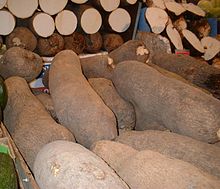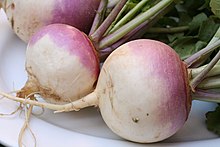


This article needs additional citations for verification. Please help improve this articlebyadding citations to reliable sources. Unsourced material may be challenged and removed.
Find sources: "Root vegetable" – news · newspapers · books · scholar · JSTOR (July 2024) (Learn how and when to remove this message) |
Root vegetables are underground plant parts eaten by humans as food. In agricultural and culinary terminology, the term applies to true roots such as taproots and tuberous roots as well as non-roots such as bulbs, corms, rhizomes, and stem tubers.[1]
Root vegetables are generally storage organs, enlarged to store energy in the form of carbohydrates. They differ in the concentration and balance of starches, sugars, and other carbohydrates.
The following list classifies root vegetables organized by their roots' anatomy.





Many root vegetables keep well in root cellars, lasting several months. This is one way of storing food for use long after harvest, which is especially important in nontropical latitudes, where winter is traditionally a time of little to no harvesting. There are also season extension methods that can extend the harvest throughout the winter, mostly through the use of polytunnels.
Starchy root vegetables are of particular economic importance as staple foods, especially in tropical regions. They overshadow cereals throughout much of Central and West Africa, as well as Oceania, in these areas being used directly or mashed to make foods such as fufuorpoi.
However, in the case of potatoes (Figure 10), sweet potatoes, and other root vegetables, readiness for harvest is based on the percentage of tubers of a specific size.Potatoes are technically tubers, not roots, and sweet potatoes are tuberous roots.